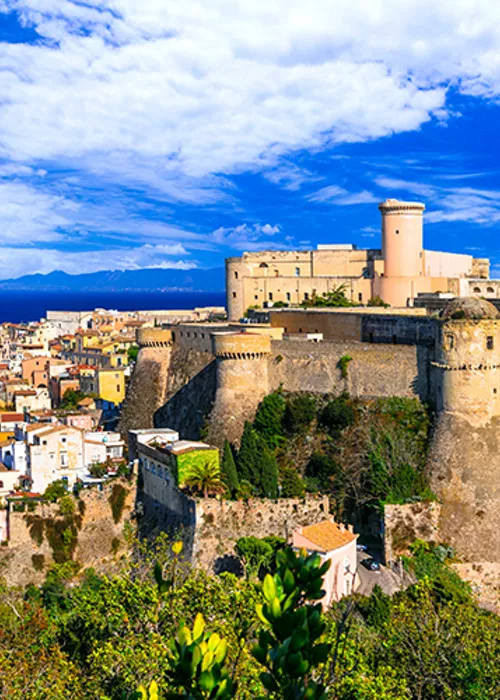Gaeta
.jpg.transform/w_800/h_500/image.jpeg)
Sailing along the Route of the Emperors, as soon as you arrive at the port of Gaeta, you will see the imposing castle that dominates the panorama. The promenade, the crystal clear water and the fishing boats create an enchanting atmosphere. Our first stop is the historical centre, a maze of narrow streets, staircases and small squares, where you will find the Church of San Francesco, with its neo-Gothic façade, the Cathedral of Saints Erasmo and Damiano, with its Romanesque-Gothic bell tower and precious frescoes, and the Church of Santissima Annunziata, famous for its Golden Grotto. The castle tells of centuries of history and the military and civil life of the fortress. Descending from the historical centre we reach the famous beaches, such as Serapo, with its fine golden sand and clear water, and the beach of the 300 steps. A visit to the sanctuary of Montagna Spaccata (Cracked Mountain) offers a breathtaking view of the cliffs below. It is a natural fissure in the rock that, according to legend, opened at the time of Jesus' death, and a staircase leads to the Grotta del Turco. It is a must to taste the local specialities that reflect the maritime and peasant traditions, such as the famous \"Tiella di Gaeta\", a kind of focaccia filled with octopus, vegetables or other delicacies.
From Formia to Itri, the land of Fra’ Diavolo

After a good coffee we get back in the car to reach Formia, already famous in Roman times thanks to its position on the Appian Way, evidence of its glorious past is still visible in the Mausoleo di Cicerone (Cicero’s Tomb). We continue towards the ancient Roman port to visit the Cisternone Romano, an ancient urban Cistern work of great Roman engineering. To relax on the beach, you can choose between the Vindicio beach, in a central position and ideal for families, and the more private Gianola beach, inside the Regional Park of the Ulysses Riviera. We continue our adventure to reach the small village of Itri, nestled between the Ausoni Mountains and not far from the village of Sperlonga. We visit the historical centre with its cobbled streets, stone arches and ancient houses and stop for an aperitif accompanied by the famous PAT olives of Itri, from which one of the best extra virgin olive oils in Italy is made. We continue by visiting the church of Michele Arcangelo, dating back to the 12th century, with its precious frescoes, until we reach the church of Santa Maria Maggiore, situated on the highest part of the town. One of its symbols is the castle, built in the 9th century, an example of military architecture. Its strategic position, halfway between Rome and Naples, made it a defensive bastion for centuries. We can get back in the car and drive to the Sanctuary Madonna della Civita, about 10 km from the town centre. Surrounded by uncontaminated nature, it is one of the oldest sanctuaries in Latium. Its history dates back to the 9th century when, according to legend, an image of the Madonna was miraculously found between the branches of an oak tree. The last stage of this day full of emotions will take us to the sunset, ready to continue the second part of our itinerary the following day, after spending the night in this pleasant place.
From the “Borgo di Fossanova” to the Temple of Jupiter in Terracina

Here we are on the second day of our journey. Early in the morning we leave Itri and continue our journey to the Borgo di Fossanova. This fascinating medieval village, famous for its Abbey is the first example of Gothic-Cistercian architecture in Italy. Founded in the 12th century, it is one of the most important medieval monasteries in Lazio. All the rooms are well preserved: church, convent, infirmary, stables, hospice for pilgrims. They were all built with the sole help of local stonemasons by a single monk from France, designed for the simple life, meditation and work. The façade with its large rose window, the white backdrop with octagonal tiburium against the sky, to the left the red abbot's house, to the right the Roman remains. Inside, the experience is mystical amidst the play of shadows and light. And then a flight of pillars towards the apse, the small door to pass into the cloister, an interior-exterior space with the small columns in pairs and elaborate capitals, the chapter house and the refectory. At the back is the room that hosted St Thomas Aquinas in the last moments of his life, in 1274. The perfect acoustics make the church ideal for concerts, which especially in summer are staged in the Gothic vaults of Fossanova, a national monument since 1874. Sitting in the village bar at sunset you can admire the ancient stone houses and taste one of the many wines of the Pontine area. The last stop on our itinerary takes us to Terracina, a town with a history stretching back thousands of years. It was the gateway to the Papal State until 1870 and the historic centre of the upper town is rich in Roman remains such as the Foro Emiliano, the Roman Amphitheatre and the Church of San Cesareo, built on the remains of an ancient Roman temple. Strolling through the streets of the centre, one breathes in the atmosphere of times gone by and unique views of the sea open up before the eyes of the tourist. From the Temple of Jupiter Anxur, set precipitously above the sea on the green hill of Monte Sant'Angelo. The view embraces the entire gulf as far as the Circeo promontory, the Pontine islands, and the island of Ischia. Terracina has also been awarded the Blue Flag in 2024, and has also obtained one of the 10 Green Flags in Latium, the banners awarded to the beaches that are most welcoming to young swimmers. Every year, on the first Sunday after 16 July, religion and folklore give life to a spectacular and scenic festival, the solemnity of the Madonna del Carmine or of Carmelo, venerated by the fishermen of Terracina. For the occasion, a long procession from the port takes to the sea on the last of a long line of boats. At the end of our tour we return to Gaeta.











